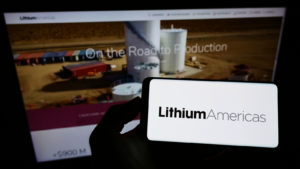
Despite recent discoveries of America’s mass of lithium deposits, the landscape around mining in the processing of lithium remains complex. Yet, demand for elemental lithium set an all-time high thanks to electric vehicle manufacturing and battery cell technology advancements. For investors, this presents a complicated, interconnected world of companies as lithium becomes ever more central to the global economy.
To determine if a particular lithium-centered company has potential, investors should focus on regulatory relationships and access to global deposits. These industry factors are strong indicators of the performance of a company due to the control most governments maintain around this metal.
For investors interested in profiting from lithium, here are three strong buy lithium stocks to keep an eye on as global demand increases.
Strong-Buy Lithium Stocks: Albemarle (ALB)

Among lithium companies, Albemarle (NYSE:ALB) stands out for both its customer portfolio and unpredictable stock performance as of late. Between layoffs and pending regulatory approvals, ALB’s value has been somewhat speculative. However, the company’s commitment to forging dependable customer relationships might make it one of the best strong-buy lithium stocks.
Currently, some of Albemarle’s largest and most prestigious customers include Samsung and Panasonic (OTCMKTS:PCRFY). Moreover, the company recently signed a multi-year agreement with BMW Group (OTCMKTS:BMWYY) to provide battery-grade lithium for future electric vehicles. A relationship such as this one ties the success of Albemarle’s lithium sales to the performance of BMW’s EV sales.
The good news for investors is that BMW’s electric vehicle sales consistently hit their targets last year. Thus, Albemarle presents a lucrative long-term opportunity for investors willing to hold the stock while lithium oversupply rocks the market.
Lithium Americas Corp (LAC)

As automakers shift towards offering more EV models, Lithium Americas‘ (NYSE:LAC) access to recently opened deposits could spell success. Thanks to its head start in developing mining operations in Thacker Pass, Nevada, LAC currently holds great potential for pricing its battery-grade lithium at attractive rates for U.S. automakers.
Furthermore, deposits in Thacker Pass are some of the most easily accessible in the country. This is primarily due to the climate of the region, which is dry, and has favorable weather conditions for mining. LAC also intends to reduce carbon emissions during extraction by using heat capture technologies to generate electricity for the money process.
With shares trading at a little under six dollars, LAC provides a relatively affordable entry into the lithium market. The company’s positioning of its deposit may also result in it being able to offer lithium below the market price. This would make it even more competitive for investors.
Piedmont Lithium (PLL)

Another of the companies to suffer workforce cuts after the lithium glut, Piedmont Lithium’s (NASDAQ:PLL) potential lies in geography. Right now, much of the conversation around lithium extraction revolves around battery-grade lithium for electric vehicles. The reality is, however, that there are three main types of lithium deposits found in varying geographic regions around the world.
This is where Piedmont finds its edge in the industry, with a consistent focus on expanding operations in several continents. This kind of extraction diversity allows Piedmont to produce lithium, depending upon the market it intends to sell to.
Furthermore, the company is seeing its 2024 lithium shipments shift towards multi-year customer contracts. This will allow for more stable sales numbers rather than the usual, volatile spot sales common in lithium trading. Investors should keep a close eye on Piedmont as it awaits regulatory approvals in Ghana and North Carolina.
On the date of publication, Viktor Zarev did not have (either directly or indirectly) any positions in the securities mentioned in this article. The opinions expressed in this article are those of the writer, subject to the InvestorPlace.com Publishing Guidelines.





